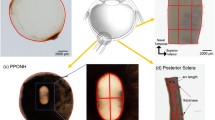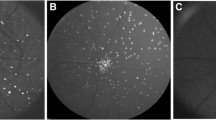Abstract
Purpose
Numerous fixative solutions are available but many are not amenable to the histomorphological preservation of retinae. The investigators specifically focused on retinal histological studies, which rather than 4% formaldehyde (FA), often use Davidson’s fixative. However the latter has its limitations. The purpose of this study was to produce a new fixative which maintains retinae closer to the in vivo conditions.
Study design
Experimental design.
Methods
Four fixative formulations (4% paraformaldehyde, Davidson’s fixative, modified Davidson’s fixative and an in-house fixative – TB-Fix) were tested on retinae and the outcomes on histomorphology and immunohistochemical staining for selected antigenic markers was compared.
Results
TB-Fix markedly improved morphological detail following hematoxylin and eosin staining, most importantly eliminating the spongiform appearance in the plexiform layer and the swelling of somata (including Müller cells), when compared to FA, Davidson’s fixative and its modified version. Retinal samples fixed with TB-Fix or FA showed comparable results in immunohistological staining for neurons and glia in the retina. Importantly, while the whole eye fixed with FA collapsed in shape and induced artificial retinal detachment, the eye fixed with TB-Fix avoided deformation and detachment. Furthermore, we found that TB-Fix also prevented detachment from the culture plate when used to fix HEK293 cells, which are known to detach from the plate easily.
Conclusion
It was demonstrated that TB-Fix provides an overall improvement in the preservation of retinal morphology and chemical composition.




Similar content being viewed by others
References
Schlosshauer B, Grauer D, Dütting D, Vanselow J. Expression of a novel Müller glia specific antigen during development and after optic nerve lesion. Development. 1991;111:789–99.
Shinoe T, Kuribayashi H, Saya H, Seiki M, Aburatani H, Watanabe S. Identification of CD44 as a cell surface marker for Müller glia precursor cells. J Neurochem. 2010;115:1633–42.
Eltoum I, Fredenburgh J, Myers RB, Grizzle WE. Introduction to the theory and practice of fixation of tissues. J Histotechnol. 2001;24:173–90.
Eldred WD, Zucker C, Karten HJ, Yazulla S. Comparison of fixation and penetration enhancement techniques for use in ultrastructural immunocytochemistry. J Histochem Cytochem. 1983;31:285–92.
Izumi Y, Hammerman SB, Benz AM, Labruyere J, Zorumski CF, Olney JW. Comparison of rat retinal fixation techniques: chemical fixation and microwave irradiation. Exp Eye Res. 2000;70:191–8.
McMenamin PG. Optimal methods for preparation and immunostaining of iris, ciliary body, and choroidal wholemounts. Investig Ophthalmol Vis Sci. 2000;41:3043–8.
Grizzle WE, Fredenburgh J, Myers RB. Fixation of tissues. In: Bancroft J, Gamble M, editors. Theory and practice of histological techniques. 6th ed. Edinburgh: Churchill Livingstone; 2007. p. 53–74.
McKay JS, Steele SJ, Ahmed G, Johnson E, Ratcliffe K. An antibody panel for immunohistochemical analysis of the retina in Davidson’s-fixed, paraffin-embedded eyes of rats. Exp Toxicol Pathol. 2009;61:91–100.
Latendresse JR, Warbrittion AR, Jonassen H, Creasy DM. Fixation of testes and eyes using a modified Davidson’s fluid: comparison with Bouin’s fluid and conventional Davidson’s fluid. Toxicol Pathol. 2002;30:524–33.
Chidlow G, Daymon M, Wood JP, Casson RJ. Localization of a wideranging panel of antigens in the rat retina by immunohistochemistry: comparison of Davidson’s solution and formalin as fixatives. J Histochem Cytochem. 2011;59:884–98.
Tokuda K, Zorumski CF, Izumi Y. Involvement of illumination in indocyanine green toxicity after its washout in the ex vivo rat retina. Retina. 2009;29:371–9.
Ogata G, Stradleigh TW, Partida GJ, Ishida AT. Dopamine and full-field illumination activate D1 and D2–D5-type receptors in adult rat retinal ganglion cells. J Comp Neurol. 2012;520:4032–49.
Margo CE, Lee A. Fixation of whole eyes: the role of fixative osmolarity in the production of tissue artifact. Graefes Arch Clin Exp Ophthalmol. 1995;233:366–70.
Vinores SA, Derevjanik NL, Mahlow J, Hackett SF, Haller JA, deJuan E, et al. Class III beta-tubulin in human retinal pigment epithelial cells in culture and in epiretinal membranes. Exp Eye Res. 1995;60:385–400.
Powner MB, Gillies MC, Zhu M, Vevis K, Hunyor AP, Fruttiger M. Loss of Müller’s cells and photoreceptors in macular telangiectasia type 2. Ophthalmology. 2013;120:2344–52.
Vardimon L, Fox LE, Moscona AA. Developmental regulation of glutamine synthetase and carbonic anhydrase II in neural retina. Proc Natl Acad Sci USA. 1986;83:9060–4.
Kondo H, Iwanaga T, Nakajima T. An immunocytochemical study on the localization of S-100 protein in the retina of rats. Cell Tissue Res. 1983;231:527–32.
Dyer MA, Cepko CL. Control of Müller glial cell proliferation and activation following retinal injury. Nat Neurosci. 2000;3:873–80.
Thomas P, Smart TG. HEK293 cell line: a vehicle for the expression of recombinant proteins. J Pharmacol Toxicol Methods. 2005;51:187–200.
Heegaard S, Rosenberg T, Preising M, Prause JU, Bek T. An unusual retinal vascular morphology in connection with a novel AIPL1 mutation in Leber’s congenital amaurosis. Br J Ophthalmol. 2003;87:980–3.
Zhong X, Ge J, Smith EL 3rd, Stell WK. Image defocus modulates activity of bipolar and amacrine cells in macaque retina. Investig Ophthalmol Vis Sci. 2004;45:2065–74.
Tabandeh H, Dubovy S, Green WR. Bilateral midperipheral large drusen and retinal pigment epithelial detachments associated with multifocal areas of choroidal neovascularization: a histopathologic study. Retina. 2006;26:1063–9.
Bell WR, Green WR, Goldberg MF. Histopathologic and trypsin digestion studies of the retina in incontinentia pigmenti. Ophthalmology. 2008;115:893–7.
Stradleigh TW, Ishida AT. Fixation strategies for retinal immunohistochemistry. Prog Retin Eye Res. 2015;48:181–202.
Kiernan JA. Histological and histochemical methods: theory and practice. 5th ed. Banbury: Scion Publishing; 2015.
Helander KG. Kinetic studies of formaldehyde binding in tissue. Biotech Histochem. 1994;69:177–9.
Ghoufi A, Artzner F, Malfreyt P. Physical properties and hydrogen-bonding network of water–ethanol mixtures from molecular dynamics simulations. J Phys Chem B. 2016;120:793–802.
Tzekov R, Lin T, Zhang KM, Jackson B, Oyejide A, Orilla W, et al. Ocular changes after photodynamic therapy. Investig Ophthalmol Vis Sci. 2006;47:377–85.
Marangoni D, Bush RA, Zeng Y, Wei LL, Ziccardi L, Vijayasarathy C, et al. Ocular and systemic safety of a recombinant AAV8 vector for X-linked retinoschisis gene therapy: GLP studies in rabbits and Rs1-KO mice. Mol Ther Methods Clin Dev. 2016;5:16011.
Steinberg RH, Reid M, Lacy PL. The distribution of rods and cones in the retina of the cat (Felis domesticus). J Comp Neurol. 1973;148:229–48.
Pow DV, Wright LL, Vaney DI. The immunocytochemical detection of amino-acid neurotransmitters in paraformaldehyde-fixed tissues. J Neurosci Methods. 1995;56:115–23.
Berod A, Hartman BK, Pujol JF. Importance of fixation in immunohistochemistry: use of formaldehyde solutions at variable pH for the localization of tyrosine-hydroxylase. J Histochem Cytochem. 1981;29:844–50.
Moran J, Hurtado S, Pasantes-Morales H. Similar properties of taurine release induced by potassium and hyposmolarity in the rat retina. Exp Eye Res. 1991;53:347–52.
Villegas GM. Ultrastructure of the human retina. J Anat. 1964;98:501–13.
Acknowledgements
The authors thank Junzo Kitoh for critical advice. The authors thank Yukari Mizuno, Shizuka Murata, Fusako Itoh and Mika Tominaga for technical assistance and support. This work was supported by JSPS KAKENHI Grant number JP16K11323.
Conflicts of interest
K. Tokuda, None; B. Baron, None; Y. Kuramitsu, None; T. Kitagawa, None; N. Tokuda, None; N. Morishige, None; M. Kobayashi, None; K. Kimura, None; K. Nakamura, None; K. Sonoda, None.
Author information
Authors and Affiliations
Corresponding author
Electronic supplementary material
Below is the link to the electronic supplementary material.
About this article
Cite this article
Tokuda, K., Baron, B., Kuramitsu, Y. et al. Optimization of fixative solution for retinal morphology: a comparison with Davidson’s fixative and other fixation solutions. Jpn J Ophthalmol 62, 481–490 (2018). https://doi.org/10.1007/s10384-018-0592-7
Received:
Accepted:
Published:
Issue Date:
DOI: https://doi.org/10.1007/s10384-018-0592-7




